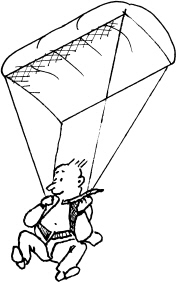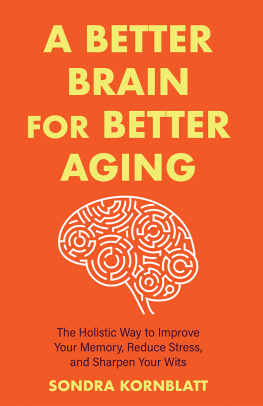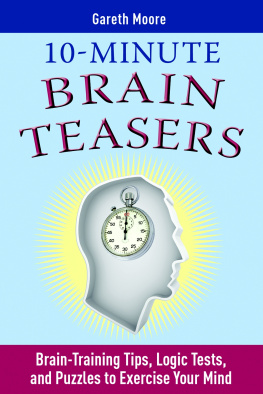Brainfit
10 Minutes a Day
for a Sharper Mind and Memory
CORINNE L. GEDIMAN
WITH FRANCIS M. CRINELLA, P H.D.

2005 by Corinne Gediman
All rights reserved. No portion of this book may be reproduced, stored in a retrieval system, or transmitted in any form or by any meanselectronic, mechanical, photocopy, recording, scanning, or otherexcept for brief quotations in critical reviews or articles, without the prior written permission of the publisher.
Published in Nashville, Tennessee, by Thomas Nelson. Thomas Nelson is a registered trademark of Thomas Nelson, Inc.
Thomas Nelson, Inc., titles may be purchased in bulk for educational, business, fund-raising, or sales promotional use. For information, please e-mail SpecialMarkets@ThomasNelson.com.
Library of Congress Cataloging-in-Publication Data
Gediman, Corinne, 1949
Brainfit : 10 minutes a day for a sharper mind and memory / Corinne Gediman.
p. cm.
Includes bibliographical references.
ISBN 978-1-4016-0223-9 (pbk.)
1.Mnemonics. 2. Intellect. I. Title.
BF385.G43 2005
153.1'4dc22
20050195101-4016-0223-1
Printed in the United States of America
09 10 11 12 13 QW 9 8 7 6 5 4 3 2
To my parents Harry and Laura Lille,
who taught me that life is a precious gift
and learning is the window that opens us up
to a rich and beautiful world full of possibilities.
Contents
Id like to say a special thank-you to the following people who helped make this book possible:
Pamela Clements, Geoff Stone, and the entire supportive staff at Rutledge Hill Press for making Brainfit a reality
Coleen OShea, my literary agent, for her wisdom and guidance
Dr. Francis Crinella, my guardian angel, for his mentorship and intellectual contributions
Anne Louise Gittleman, the First Lady of Nutrition, for opening the window
Bonnie Lynn Simon, Ph.D., for her design input and moral support
Julie Paige for her creative input and keeping me on task
Barbara Bushner for her expertise in the self-help book market
Barry Gediman for always believing in me
Some individuals seem to have a better memory than others, and there is a wide belief that a strong memory capacity is a God-given talent that has been bestowed on some but not all. We often hear people complain about their poor or worsening memory and are sympathetic but at the same time chalk it up to the inevitable. It may even be you who has a poorer memory capacity than others and has come to accept the cultural stereotype that the gap between your present day memory capacity and that of your youth will only widen. Is there nothing that can be done to improve memory, or is memory capacity an immutable hereditary trait like red hair or blue eyes?
In 1985, at the University of California, Irvine, we began a major research experiment to find out if age-related decline in memory was an inevitable consequence of aging or whether something might be done to reverse the processor at least slow it down. Several hundred retired, senior citizens took part in a program of daily activities that were designed to improve physical and mental health, including mental exercises that were thought to be useful in slowing down age-related memory decline. To our delight, when we re-tested our senior citizens in 1990, we found that a program of daily mental exercises did put the brakes on age-related decline in mental functions, including memory. In some cases, seventy-five year olds were better at playing a wide number of mental games than they had been five years earlier. Standardized tests of memory showed a slowing of the rate of mental decline in some and actual improvement in others. This was one of the earliest experiments to demonstrate that memory decline was not an inevitable by-product of aging. How might this dramatic improvement have occurred? We now know that even among senior citizens a process called neural plasticity is present-the brain continues to change or remodel itself in order to improve mental functioning, even in eighty and ninety year olds!
Memory is the best evidence for the presence of neural plasticity. An older person, after reading the morning paper, knows something now that he or she did not know before. Depending on how important the new information might be, and how well it becomes organized in the person's memory banks, the information will remain available for recall and use. Neural plasticity is also evident when we fail to remember information that was once known-forgetting. Erasing what was once important but now less important, or what was once believed to be true but is now known to be false, leads to a less cluttered and more efficient mind.
When we started the senior citizens research program, we did not have a formal mental training program. We believed that mental activity could improve memory but had to craft our own set of mental exercises on a trial and error basisnothing like Brainfit was available. Now, in the following pages, the reader will find a systematic set of exercises, each adapted from the latest research on human memory, which have been carefully designed and sequenced so that memory and mental efficiency will improve. Each exercise has been designed to challenge the student, and the format is such that each challenge will be enjoyable. The outcome of the Brainfit program will, of course, depend on the commitment and diligence of the student, but there is no doubt that with a modest effort, memory and mental efficiency are bound to improve.
Francis M. Crinella, Ph.D.
Clinical Professor of Pediatrics,
Psychiatry & Human Behavior, and
Physical Medicine & Rehabilitation
University of California, Irvine
Chapter One
Regain Your Brain

The mind is like a parachute...
it doesnt work unless it is open.
ANONYMOUS
A Modern Fairy Tale
Imagine a now middle-aged Sleeping Beauty and Prince Charming. Theyve had a little cosmetic surgery, work out regularly at the health club, eat a low-carb diet and attend Pilates classes regularly. They check their good and bad cholesterol yearly, drink a glass of red wine a day, and indulge in the occasional massage. Aging well is a top priority, and they understand the importance of a healthy lifestyle.
Every morning, they ask the magic mirror the proverbial question (with a twenty-first century twist).Mirror, mirror on the wall, who is the youngest of us all? The mirror answers back, You guys look awesome, but may I suggest a PET brain scan to check out your aging brain? After all, what good is an attractive and fit body if you are not going to be mentally present to enjoy it?!
And the moral of the story is... Dont forget to make brain fitness part of your antiaging strategy.
Searching for the Fountain of Youth
Henry Wadsworth Longfellow once said, Youth comes but once in a lifetime. If Mr. Longfellow were alive today, he would marvel at how the scientific advances of the twenty-first century are creating ways for us to rejuvenate ourselves and live well into our nineties. Science and medicine are allowing us to replace aging body parts, transplant thinning hair, revitalize our libido, as well as nip, tuck, and lift anything that sags. But staying young is not just a matter of physical fitness and cardiovascular health; it is also a matter of brain fitness. For those who seek the fountain of youth, its time to make brain fitness the next battleground on the antiaging front. Before you don your brain gladiator attire, however, its helpful to understand what you have working for you and against you. So, lets begin with an understanding of how the brain ages.
Next page








